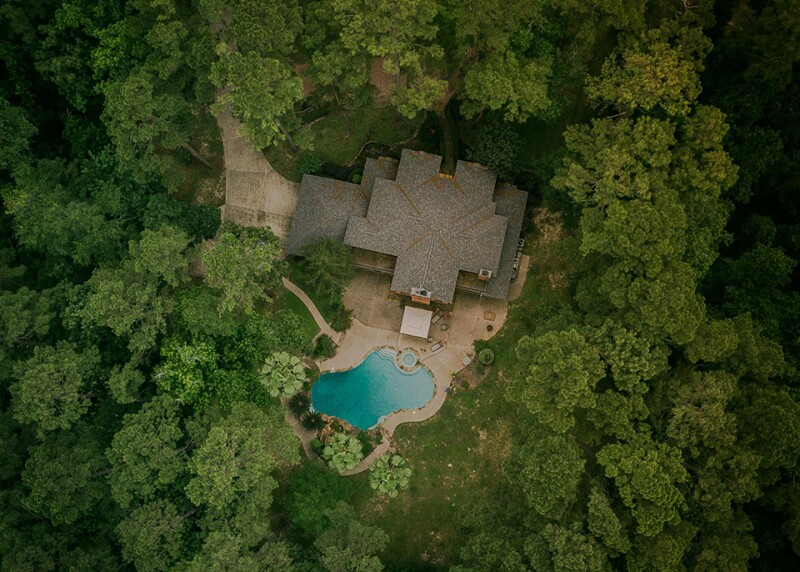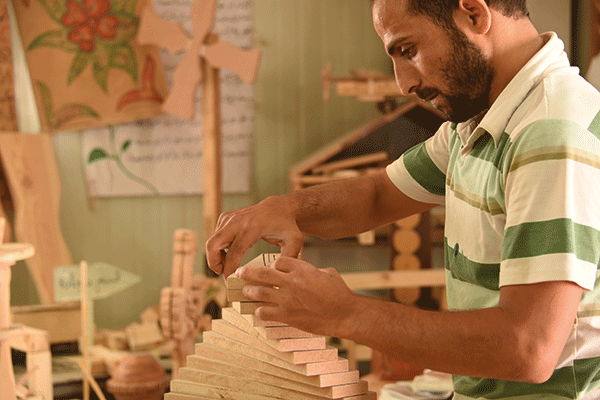 |
|
As part of the Norwegian Refugee Council’s Youth Programme in Za’atari camp, Syrian refugees receive training on carpentry, painting and blacksmithing. NRC then helps them find employment opportunities inside and outside the camp |
 |
Amani Roumieh used to work for the ministry of energy in Damascus before her twins were born. Supported by her husband who owned two petrol stations, she left her job to open up a shop so she could spend more time with her children.
That was until 2011, when the war broke out in Syria. Seeking refuge with extended family members in Lebanon, Roumieh, her husband and their three-year-olds fled the country and waited to see if the situation would improve. Not only did it not improve, it worsened, and as months turned into years, Roumieh says, living in Lebanon without work became increasingly difficult.
She considers her family fortunate, however. For one, they left early enough in the crisis to be able to bring most of their belongings with them. Second, the apartment building she rents in Aley, a small hillside town about 15 minutes outside of Beirut, happens to be above the branch office of Al Majmoua, a micro-finance institution (MFI) serving economically depressed Lebanese and refugees.
With a $1,000 loan from the MFI guaranteed by a supportive landlord, Roumieh was able to make improvements to a small commercial space on the main street downstairs, converting it into a store similar to the one she had owned in Damascus. The loan from Al Majmoua also helped her purchase stock, clothes she imports from her former contacts in Turkey and Syria.
While Roumieh meets the loan repayments, business is not booming, she confesses. The competition from other refugees is fierce and the Lebanese economy has taken a beating since the crisis began. The number of Lebanese living below the poverty line has risen by 66% since the war broke out, as the country has struggled to integrate more than 1 million refugees (20% of its local population). Unemployment is reported to be 9%, but that figure is believed to be far lower than the actual rate. Among youth, the rate is over 30%.
“At least thanks to this loan I have work and can provide for my family,” says Roumieh. “If you don’t have work, you don’t survive and where would we go? This is our home right now.”
Donor fatigue
It’s been more than six years since the first anti-government demonstrations in Syria sparked a war that has so far claimed almost 500,000 lives and resulted in an estimated 5 million Syrians fleeing the country. The majority have ended up in neighbouring Turkey, Lebanon and Jordan, receiving emergency relief from non-governmental organizations. But acceptance is dawning on all sides that no one is going home to Syria soon.
Across the world, conflicts are lasting longer. There are some 65 million displaced people worldwide as a result of conflict – 21 million of these have left their countries. How long will they be away? Those in camps will remain there, on average, between 10 and 15 years.
Further aggravating the Syrian refugee crisis is donor fatigue. There are simply too many long-running crises globally. In Africa, which hosts 80% of the world’s refugees, South Sudan’s war has been raging for almost four years and Somalia’s almost eight. And not far from Syria in Yemen, the world’s largest humanitarian crisis barely even makes news – there, almost 20 million people are in need of humanitarian aid and more than 500,000 have contracted cholera in the midst of a war that began two-and-a-half years ago. There are simply not enough donations to go round.
According to the United Nations, $4.5 billion was required to meet the urgent needs of the most vulnerable Syrians in 2016, but only $2.9 billion was received. The World Food Programme (WFP) in Jordan has only sufficient funds to serve almost half-a-million refugees until October this year.
“Imagine telling a mother with three children that this month she will only have JD50 ($70) instead of JD100 to feed her family. That’s what we had to do in 2015. At the moment, it looks like we will have to do that again,” says Shaza Moghraby at the WFP in Amman.
What has become obvious to all NGOs and host country governments is that longer-term solutions to humanitarian crises are needed – perhaps an entire shift in mindset.
 |
| Kilian Kleinschmidt, founder of humanitarian consultancy Switxboard |
“There is a narrative around refugees that needs to change. For too long we have looked at them in terms of aid only and we consider them to be ‘good’ refugees if they are planning to go home,” says Kilian Kleinschmidt, founder of humanitarian consultancy Switxboard and who used to run Jordan’s largest Syrian refugee camp for the UN High Commission for Refugees.
“This mindset prevents us from seeing these people as humans, as people who had jobs and careers, and who have lost their right to work and to provide for themselves and their families. The humanitarian ‘industry’ needs to change towards helping displaced persons set up a new life and work, instead of keeping them dependent.”
Integration
NGOs and host countries cannot make this shift alone. Last year, Jordan announced the Jordan Compact at the London donor conference, which puts forward a long-term solution to integrating Syrian refugees, including job creation for refugees and Jordanians who, like the Lebanese, have been impacted by the estimated 1.4 million Syrian refugees now living there.
Jordan’s unemployment rate is 18.4%; the highest the country has seen in 25 years. Among those it is has asked for new solutions and assistance are the finance industry and the private sector.
Some are responding.
In October, Citi, through its foundation’s Pathways for Progress programme, launched an initiative with the International Rescue Committee (IRC) to train almost 1,000 refugees in Nigeria, Greece and Jordan and help place them in available positions. As the programme focuses on youth employability and entrepreneurship skills, Citi’s EMEA CEO, Jim Cowles, says it therefore also has a role to play in helping refugees and internally displaced people fulfil their goal of becoming contributing members of the economy.
Citi is the only global bank to respond as yet and its initiative is imperative in the short term.
Unable to support themselves and nervous that their aid will be cut, refugees, one aid worker says, are still sending young family members to make the perilous journey to Turkey and then by boat to Greece in the hope of finding work in Europe.
In July, 1,000 refugees and migrants came ashore in Greece, according to aid workers.
But there is much that can be done beyond corporate social responsibility efforts by banks and the private sector. Long-term solutions are needed in a way that the humanitarian industry has not seen before because the number of people making such journeys is likely to increase. The UNHCR estimates that the world could see 250 million displaced people by 2050, mostly because of climate change, let alone the millions that may be fleeing conflict.
Those people have to go somewhere and they will need to be integrated and be able to support themselves. Innovative investment structures that support job creation and training, as well as bolstering local economies, must be part of any solution for the world’s humanitarian crises.
When it comes to helping the poor globally create a sustainable life, the responsibility has fallen chiefly on local microfinance institutions. They have also become the main formal lenders to refugees that are not in camps.
There are only a handful of such institutions in Lebanon and Jordan, and with such large numbers of refugees arriving in a short amount of time, they have faced a steep learning curve. Their experience, however, offers valuable insights for larger financial services institutions considering serving not just refugees, but also migrants and asylum seekers around the world.
Closing the gap
Al Majmoua was set up by Save the Children in the mid 1990s to serve vulnerable women and is the largest MFI in Lebanon. It became independent in 1998 and now serves 70,000 clients, including refugees from Syria and Iraq and migrant workers from the Philippines, Sri Lanka and neighbouring Arab countries. In addition to offering small business loans, it offers free financial, business and vocational training.
Youssef Fawaz has been with Al Majmoua since its inception and says that there is a gap between the support offered by relief agencies and governments and the traditional financial services sector that desperately needs closing.
“The ultra-poor need food and assistance – not debt, as they would drown in it – and they are typically served by NGOs and government agencies,” he says. “But then there are those marginalized by the formal financial sector for a variety of reasons and they need just a small amount of money to get on their feet, to start a small business – perhaps even just a $300 loan.”
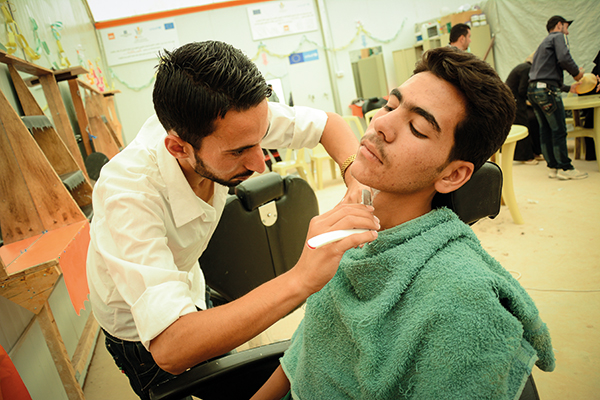 |
|
Refugee intiative: Sami practices shaving during the Barber and Hairstyling class at NRC’s youth training centre in Za’atari refugee camp in Jordan |
Banks typically consider that size of loan to be too small, and tend to refuse refugees or the very poor. Al Majmoua, on the other hand, is designed to serve people who do not have a steady income, often have no credit history and certainly do not have much in the way of fixed assets or collateral they can pledge against loans. There is also the issue of flight risk that makes banks cautious.
Al Majmoua itself learned a tough lesson about flight risk. During the Iraq war, it offered loans to Iraqi refugees in Lebanon, many of whom ultimately used the money to finance travel to Europe and North America. Two years ago, several of its Syrian clients also left without notice to join the wave of refugees heading to Europe. And it was not only refugee clients – many Lebanese clients piggybacked on the Syrian crisis and fled the country without repaying loans.
“The flight risk can stand in the way of offering loans, we understand, but we don’t look at it that way,” admits Fawaz. “It is the human thing to do – to help someone who is trying to get on their feet – but we have also learned to be more cautious.”
One way Al Majmoua has kept flight risk down is through hiring loan officers in the communities targeted. Its agents make home visits and interview neighbours, spouses, customers, suppliers and employers of potential loan recipients to build a client profile. It is also working on teaming up with a Syrian microfinance institution, which could incentivize clients to keep a good credit history as they would carry it with them when they return. These days flight risk is lower. European countries are closing their borders and the hope of returning to Syria looks evermore distant.
That has brought other challenges, chiefly discontent among the working poor in Lebanon. A few towns display banners declaring that refugees are unwelcome. There are also reports of stores owned by Syrian refugees being closed by local municipalities. It is an uncomfortable situation – some of Lebanon’s new residents will accept lower incomes than the Lebanese and therefore undercut local prices.
People prefer to work than to just receive a handout. For some, direct cash assistance can come with a sense of shame, but we notice that those who work are happier – Tatiana Sibaai, Danish Refugee Council
That produces conflict among clients. When Al Majmoua approached its Lebanese clients to ask how they would feel if they started offering loans to Syrian refugees, they unanimously said it would be disloyal.
“So we listened and instead focused on offering refugees non-financial services – typically to women as they were seen as less threatening than men because they worked from home,” says Fawaz. Training schemes were done alongside Lebanese women to improve communication between the groups.
Women who met each other began to build relationships, says Fawaz, and from there Al Majmoua began asking Lebanese women in borrowing groups if they would accept a Syrian woman into their circle.
“With patience, that tension can be overcome,” says Fawaz. Now Al Majmoua feels comfortable offering direct loans to people like Roumieh.
The experience of Al Majmoua should be an encouragement to other financial institutions to follow suit. Fawaz points out that Al Majmoua has been financially sustainable since 2003. Microfinance is labour intensive (Al Majmoua has 400 employees), but the NGO makes a profit, which it puts back into its non-financial services, and less than 1% of its loans are in default. Fawaz adds that there is a lot of room for expansion.
In Jordan, access to cheap capital is the challenge for the MFIs. Microfund for Women (MfW) is the main MFI in Jordan serving refugees and low-income Jordanians with startup, business and group loans. It too was born out of an initiative by Save the Children and has 140,000 clients, 3,600 of whom are Syrian refugees. Default rates are zero, in part because all loans are coupled with micro-insurance.
“Ill-health leads to defaults,” says Eyad Nino, MfW’s deputy general manager for strategic planning and operations. “If a person is absent from their business for just one week, the business can fail. So we provide hospital insurance and life insurance through a partnership with an insurance company.”
And to limit flight risk, all loans to Syrian refugees are also made through group lending; 50% of the group must be Jordanian. Again, almost all loans are to women.
Nino is a passionate believer that much more could be done if the international and national financial industry were to show their support: “The struggle is that we are borrowing from banks to fund the loans at high interest rates and we’re having to pass that on. We would be able to help many more people if funding costs were lower. What we want to say to the international financial services industry is: ‘OK, if your country isn’t prepared to take refugees, then you can help them another way. Lend to us at lower rates.’”
Bdour Al-Hyari, business development manager at MfW, says that with the prolonged crisis, this is now what is needed. The MFI has identified another 150,000 potential clients, for example, that have had the training to be able to start work; what they need, however, is affordable financing. With financial institutions slow to help, MfW is exploring partnerships with alternative funding sources. It received a $2 million grant from the EBRD earlier this year and is looking to partner with charitable crowd-funding platform, Kiva, where loan capital for entrepreneurs could be crowd-sourced globally.
Finding work
NGOs have also begun to move into the realm of helping refugees find work. There are several thousand NGO cash-for-work positions both within the camps and outside in teaching assistance, maintenance, tailoring, construction and with the NGOs themselves. But it is not a long-term solution. The roles are typically revolved every one to three months to ensure everyone gets to work.
In August, job permits also began being issued in the camps, allowing refugees to work in specific sectors such as agriculture and construction – sectors identified as not eating into Jordanian jobs. About 800 have been issued within camps, and more than 50,000 have been issued in total of the government’s target of 200,000.
It is generous of Jordan, given its own unemployment issues and other countries’ limited offers of work, but it will not be enough. There are some 120,000 refugees just in Jordan’s two main camps, Za’atari and Azraq, and so NGOs have started
to help camp residents create their own businesses.
“Most of the people here are used to working and have now depleted any cash they brought with them,” says Tatiana Sibaai of the Danish Refugee Council (DRC). “The number-one thing they ask for is a job opportunity. People prefer to work than to just receive a handout. For some, direct cash assistance can come with a sense of shame, but we notice that those who work are happier.”
 |
|
Refugees are developing their own market economy on the Champs Elysees of Za’atari refugee camp |
She points to Za’atari camp as evidence of the potential for a vibrant economy. Due to Za’atari’s organic development, entrepreneurship has quickly sprung up. Syria’s economy was predominantly family stores and entrepreneurship was part of the culture. The camp has around 1,000 small businesses, most of which are on two shopping ‘streets’, referred to by the refugees as the Champs Elysees. Now the storefronts themselves are highly coveted and can be sold for as much as JD50,000 if one can find an informal loan from a relative to buy one.
Azraq, however, was set up much later in 2014 as the Za’atari camp hit capacity and the number of Syrians at the Jordanian border grew to more than 20,000.
Azraq is considered the camp where lessons have been learned, and so has a more formal structure.
To own a formal storefront requires a licence that the Jordanian government and UNHCR working together issue to the most vulnerable of refugees only.
It is a start, but there are 40,000 refugees in Azraq and only 100 licences have been handed out so far, 50 to Syrian refugees and 50 to external Jordanians. And while the system seeks to be fairer, it does not consider business acumen and some of the stores fail, never to be opened again.
It has encouraged the DRC to move into offering business grants to increase the opportunities for work in Azraq. That opportunity is crucial for many reasons. As was acknowledged by the Jordan Compact – signed in London in 2016 between the Kingdom and the international community – refugees need access to more durable solutions that go beyond the basic assistance they receive from the aid agencies (about JD20 a week), particularly as donor fatigue increases.
Another reason is that as NGOs have been able to shift from emergency response to providing additional services, like the psycho-social support the DRC offers, it has become clear that keeping busy and having a purpose and goal can go a long way to alleviating the emotional trauma that affects a large proportion of the camps’ residents. Prolonged boredom, the inability to support oneself, combined with emotional trauma are a recipe for trouble in many forms, especially among the young.
One donor points out the tragedy of such a situation: “So many young men left or were sent out of Syria by their families precisely to avoid being forced to serve in any of the numerous militia that exist in Syria, including the Islamic State. It is our duty as global citizens to protect those men, therefore, and we can do that by helping them build a life.”
One of the DRC’s first grants was to cousins Ali Al Ibrahim and Noura Al Mahmoud, both of whom have been in Azraq three years.
|
|
|
Noura Al Mahmoud’s bridal salon |
Al Mahmoud, 24 years old, had not worked in Syria, but took an in-camp training in hairdressing and beauty. She saw an opportunity to open a bridal salon in her caravan within the camp. It can be hard to conceive for those who have not been to a camp, but life goes on, and weddings are frequent, as are the many other celebrations of life.
Supported by Al Ibrahim, who is responsible for the purchase of items, marketing and the finance of their business, Al Mahmoud asked for a business grant from the DRC to buy things such as a mirror, chairs and hair tongs from the camp supermarket. From a JD300 loan, she turned part of her family’s caravan into a salon, producing JD85 in revenue in the first month of operation.
“It’s a start,” says Reem Alafaghani, the DRC’s senior livelihoods officer at Azraq camp. “Running this business, they are able to depend a little on themselves and provide for their respective spouses and children.”
The extra earnings also enable refugees to make their lives more comfortable. Indeed, six years into the crisis, tents have been replaced by more stable structures such as Al Mahmoud’s caravan that now have some electricity at certain times of the day and basic plumbing. With money, there is nothing that cannot be bought to be more comfortable in the camps. Washing machines, air conditioning units, cameras, mobile phones, clothes and furniture can all be purchased on the Champs Elysee or in Azraq’s market and supermarket.
Lack of resources
This is a new venture for the DRC. So far, only eight people have been given grants out of 17 proposals (with the intention to distribute up to 80 more this year). Business ideas have included shoe repair, much needed in the harsh terrain of the camps; a candy floss stall for children; furniture making; pickling; and a delivery service from the camp supermarket. All applicants are required to take a 15-hour financial literacy training course; if they receive a grant, they are offered business development training. Those turned down are also offered advice and encouraged to resubmit proposals.
Sibaai says the DRC would benefit from a long-term private-sector partner or financial services company that would be able to tailor a sustainable lending programme. While they are being approached by donors to help with business grants, they lack the resources and experience to accelerate their pace. “We are just nine people here in Azraq,” points out Sibaai.
She adds that there are many options to be explored to help people get on their feet and start building a life, such as another DRC programme where JD20 was given to several refugees that had tailoring skills for the purchase of materials.
“From that small amount, the tailors have been able to create clothes and sell them for a small profit, which has enabled them to buy more materials and so on,” says Sibaai. “We are offering space for the refugees to have a clothes market so they can get their businesses going, and we hope to offer more advanced tailoring training to help them hone their skills.”
Mercy Corps, one of the largest NGOs in the world, is also answering the call. It supports vulnerable Jordanians and Syrian refugees through humanitarian relief, economic opportunities, social stability, water and renewable energy.
As part of its research into how to support refugees’ financial inclusion, the NGO highlighted a need for loans for the new store owners in Azraq’s camp and partnered with a women’s community cooperative in Azraq town to establish an interest-free revolving loan fund, after failing to find an MFI that operated in the camps.
“The second-best option in terms of sustainability was to go with the co-op and it’s working well,” says Lorenz Wild, Mercy Corps’ economic opportunities and market development director in Amman.
Mercy Corps is also working on economic development and job creation in Jordan itself.
“With the population increase, rental prices have gone up, while wage rates in the informal sector have decreased and public services such as schools, parks and health centres are being used by more people,” says Wild. “The sentiment of the poorest Jordanians is that they are hosting neighbours and friends, but with a stagnant economy and the Syrian and Iraqi border closures they are struggling too.”
The NGO has two main projects designed to strengthen the olive oil and dairy sectors in northern Jordan.
“Instead of providing solutions directly as an NGO, we aim to stay outside the market and strengthen the system by creating partnerships with Jordanian market players,” says Wild. For example, it partnered with Jordan’s National Centre for Agriculture Research Extension to offer training in best practice for dairy farmers and processors, and in basic business skills such as marketing and sales. It then links farmers to medium-sized processing companies. So far, the companies Mercy Corps has worked with anticipate an increase in profits of between 30% and 60% and plan on hiring more workers.
Technology hub
Technology is another industry that the Jordanian government hopes, with development, may alleviate some of the youth employment challenges the country faces, which are similar to Lebanon’s.
After Yahoo! acquired Amman-based Maktoob (the first Arabic/English email service provider) in 2009, there have been several investments to support the growth of Jordan as a technology hub in the Middle East and north Africa. These include the development of the King Hussein business park in Amman that is home to companies such as Microsoft and Samsung and hosts tech and creative startup accelerator Oasis500 and telecoms company Zain’s co-working space, Zinc.
Nora Moughrabi is the marketing and PR officer for Oasis500, which is funded by venture capital and the King Abdullah II development fund. It has seen 130 startups come through its doors, including some founded by refugees.
“Given our economy, 60,000 jobs need to be created every year,” she says. “There’s really no alternative than to encourage companies to come here or to support the creation of new businesses.” In May, Expedia announced it would open a software development office in Amman.
There is a sense that technology could be an industry that benefits both Jordanians and refugees – if the training is there. That is where ReBootKamp (RBK) enters the picture.
Founded by Hugh Bosely, who has worked in Silicon Valley, RBK’s model provides accelerated training in software development and coding for both Jordanians and refugees. Bosely points out that by 2025, the skills gap in tech is going to be about 1.5 million employees worldwide.
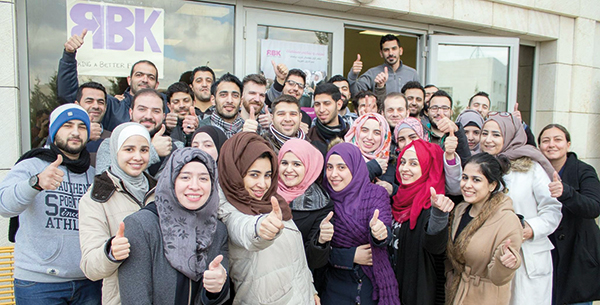 |
||
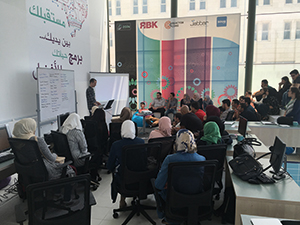 |
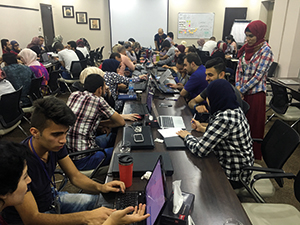 |
|
|
Students celebrate graduating (top) from RBK, which provides accelerated training in software development and coding for both Jordanians and refugees (above, left and right) |
||
“Already there are hundreds of thousands of vacancies that need to be filled,” he says. “So Silicon Valley will need to outsource. Why not do so to regions that are suffering the impact of humanitarian crises?”
RBK works directly with hiring partners – some 30 in total. Students take two highly intensive courses spanning 19 weeks. From 2,000 applicants with different work experience, age, gender and ethnicity, about 60 are chosen and some 40 will graduate and be put forward for jobs. Of 47 graduated thus far, 36 have found permanent employment locally. The rest are expected to be in work within six months of graduation.
Bosely points out that the curriculum could be easily adapted from software engineering to medicine, architecture or mathematics, and that many of the skills produced are not only industry specific – such as leadership and confidence. Tuition is $7,000 per student with support from SAP, UNDP, NGO Spark and the DRC. For those not covered by a scholarship, RBK uses a deferred tuition model, taking 18% of a graduate’s monthly pay until their debt is paid.
Mercy Corp’s Wild points to Gaza Sky Geeks as another example of where jobs can be created in tech.
Gaza Sky Geeks is a tech incubator and co-working space in Gaza that was founded in partnership with Google and Mercy Corps. It offers an online freelancing academy and coding academy to help youth get work as online freelancers and to launch their own tech companies.
Commitment
It requires a commitment by companies to seek out refugee hires. Western Union for example has outsourced some of its coding and data entry jobs to refugees as part of its corporate commitment to the community. It is working with the International Rescue Committee. The two also worked with online course provider Udemy to see if there are courses that could be created by refugees.
People in the Za’atari camp were approached and Safa’a Sukkariah asked to create an online course on plumbing. Due to cultural norms, women cannot invite men into their home to make repairs without another trusted man being present, so Sukkariah found there was a need for skilled female plumbers. She now has a pay-to-train course on Udemy’s website.
Initiatives like Gaza Sky Geeks and RBK are obvious examples of what could be included in an impact fund or social impact bond. So too is RefuAid’s initiative in the UK with refugees. There, it teams up with local English language schools so that empty seats can be taken by refugees.
“One of our clients, for example, was a neurosurgeon in Syria, yet because his English was not fluent, he was unable to get a job,” says Anna Jones, co-founder of non-profit RefuAid. “That is easily fixed. There are many cases of qualified refugees who would be able to get a well-paying job if there was an investment in language proficiency.”
So far there have been no humanitarian social impact bonds that focus on jobs. Belgian impact investment firm Kois Invest may be about to change that however. It has been working on an impact bond for job creation in response to refugee crises in the Middle East through a grant from non-profit Convergence in Canada.
Elina Sarkisova, who is involved in the refugee impact bond project at Kois, says the firm is hoping to create a bond structure in which private investors provide working capital to service providers that are delivering evidence-based livelihood programmes to Syrian refugees. Donors pay back investors if and when social outcomes are achieved, with a financial return that varies with the level of social impact. The bond focuses on employment and entrepreneurship in Jordan, Lebanon and Turkey, for both refugees and vulnerable local populations.
Sarkisova says the firm has just completed a seven-month feasibility study and it is too soon to say what the size or who the partners will be, but it plans to move into the structuring phase this year, with an expected launch in mid-2018.
“It’s not easy for sure,” she says. “There are political considerations, the issue of work permits and regulation, and finding the right partners to work with is challenging. All this and a sharp focus on not creating any distortionary factors… but this crisis isn’t going anywhere. Developing a jobs market is key in bridging the gap between emergency aid and long-term development.”
Urgency
There is a growing sense of urgency around bridging that gap. Jordan and Lebanon have taken twice as many Syrian refugees as the whole of Europe and North America combined. Aside from the moral issue of assisting these countries, it is in everyone’s interest to limit further tension in the Middle East caused by high unemployment and poverty – Jordan is the one of the few stable countries in that region.
The western world needs to figure out sooner rather than later the best ways to create new jobs in countries affected by climate change and conflict.
Some have made a start. The government of Germany, which has accepted about half a million Syrian refugees, is already running research projects in Africa to see what can be done to create jobs or retrain people forced to leave the ever-expanding Sahel. It is also partnering in research in countries such as Armenia that have suffered from net emigration and could therefore benefit from skilled migrants. (About 30,000 Syrians are thought to have resettled in Armenia).
It makes sense to act preemptively. Italy, for example, is struggling to absorb the 82,000 economic migrants that arrived by boat from Africa this year alone. The work done now in creating jobs for Syrian refugees might well provide solutions that will prove invaluable in the years to come.
“Tens of millions of people without the ability to support themselves is a humanitarian crisis, and collectively we need to recognize that,” says Kleinschmidt. “In Uganda, the government wants to give land to 1 million refugees from South Sudan so that they can start a new life – only it can’t find donor or investment money because that initiative is not seen traditionally as a humanitarian response. Our mindset needs to shift.”
That is why Kleinschmidt founded Switxboard, a network to help governments, private sector, academia, agencies, NGOs, financial institutions, and digital innovators connect and help excluded communities access global resources and develop their opportunities.
If we are to tackle ever-longer, ever-more complex humanitarian crises, rather than prolong them, everyone will have to work together.





